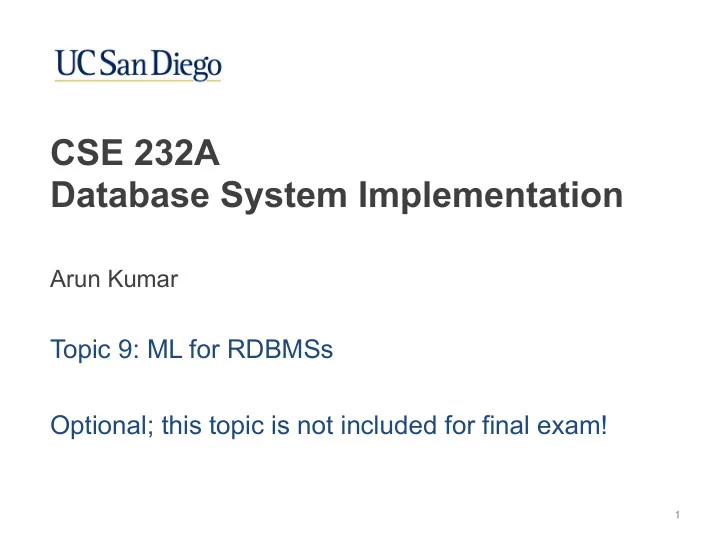

CSE 232A Database System Implementation Arun Kumar Topic 9: ML for RDBMSs Optional; this topic is not included for final exam! 1
ML for Systems Q: Why bother applying ML to well-studied systems issues? ❖ Jeff Dean’s rationales (from NIPS MLSys’17 keynote): ❖ Hand-crafted heuristics are pervasive but not very adaptive; data-driven ML can improve system metrics ❖ User-tunable knobs have exploded and are painful ❖ Hardware has caught up with ML/DL demands; cloud resources are cheap and widely available ❖ Automated ML simplifies use of ML for systems ❖ Also, cynically: “ML for Systems” is a hot/ controversial topic for publications! May get a lot of (not all wanted) attention! :) http://learningsys.org/nips17/assets/slides/dean-nips17.pdf 2
ML for Systems http://learningsys.org/nips17/assets/slides/dean-nips17.pdf 3
ML for Systems http://learningsys.org/nips17/assets/slides/dean-nips17.pdf 4
ML for Systems http://learningsys.org/nips17/assets/slides/dean-nips17.pdf 5
ML for an RDBMS Q: Where may ML be helpful in an RDBMS? Natural language interfaces (NLIs) Learned Query Processing and Opt. Learned Access Methods Learned Caching/ Scheduling Policies ML for Knob Tuning and Resource Management 6
ML for Knob Tuning/Resource Mgmt ❖ Motivation: Modern RDBMSs have 100s of config parameters (buffers for EMS, degree of parallelism, etc.) ❖ Mixture of continuous and discrete parameters ❖ Effects on query latency, etc. can be non-monotonic ❖ Optimal settings highly dependent on schema properties, database instance, hardware, auxiliary data structures, and query workload properties ❖ Impossible for DBAs to keep up, esp. cloud ❖ Why ML? Adapt quickly to instance/query workload/etc.; target flexibility (latency/utilization/etc.); can be more accurate ❖ “Autonomous”/“Self-driving” are the industry buzzwords 7
Example 8 https://www.cs.cmu.edu/~pavlo/papers/p1009-van-aken.pdf
Natural Language Interfaces (NLIs) ❖ Motivation: SQL is too hard for non-technical business users (sales, marketing, etc.) and lay public ❖ NLIs allow more people to exploit relational databases ❖ No need to learn complex syntax or even schema details ❖ Regular conversational style interactions ❖ Why ML? State-of-the-art in natural language processing (NLP) is DL-based; pure parsing/rule-based is too brittle ❖ Extremely challenging to automatically infer both structure and literals from NL query to translate to proper SQL! ❖ AFAIK, no robust open-domain commercial system today 9
Example 10 https://arxiv.org/pdf/1804.00401.pdf
Learned Scheduling/Caching Policies ❖ Motivation: Existing heuristic policies may not exploit data/ query distributions well and thus waste runtime ❖ Why ML? By learning the underlying data/workload distributions, ML can help reduce runtimes/resource wastage ❖ Learned schedulers: better load balancing to reduce worker idle times to improve utilization and/or latency ❖ Learned caching/buffering: better retention and eviction decisions to increase cache hits and reduce latency 11
Examples http://alexbeutel.com/papers/CIDR2019_SageDB.pdf 12 https://arxiv.org/pdf/1907.02394.pdf
Learned Access Methods ❖ Motivation: Existing access methods may be wasting some system resources (memory, storage, runtime, etc.) because they do not exploit database instance distributions ❖ Why ML? By learning/approximating the underlying data distributions, ML can help reduce resource demands ❖ Resource reduction target depends on use-case ❖ Learned index structures: reduce memory/storage footprint of index, while maintaining or reducing query latency ❖ Learned compression formats: reduce memory/storage footprint and file I/O time 13
Examples https://www.cl.cam.ac.uk/~ey204/teaching/ACS/R244_2018_2019/papers/Kraska_SIGMOD_2018.pdf 14 https://arxiv.org/pdf/1905.08898.pdf ; https://arxiv.org/pdf/1912.01668.pdf https://ieeexplore.ieee.org/document/8712659?denied=
Learned Query Processing ❖ Motivation: Existing phy. op. impl. are not exploiting database instance distributions well; can save some runtime or improve runtime predictability by doing so ❖ Why ML? By learning/approximating the underlying data distributions, ML can reduce runtimes/improve accuracy ❖ Learned sorting: the closer the distribution is to pre-sorted, the less time we can spend on sorting ❖ Learned joins: learn the distribution and location of the join attributes to reduce hash look up and/or sorting needs ❖ Learned query plans: Improve runtime predictability 15
Examples http://alexbeutel.com/papers/CIDR2019_SageDB.pdf 16 http://www.vldb.org/pvldb/vol12/p1733-marcus.pdf
Learned Query Optimizers ❖ Motivation: Existing optimizers have many heuristics (join orders, plan selection, cardinality estimation, etc.) ❖ Why ML? By learning/approximating the underlying data distributions, ML can reduce runtimes for final plan ❖ Learned join order: Use join attribute distribution info and reinforcement learning to figure better join orders ❖ Learned plan rewrites: Use database instance properties and attribute distributions to rewrite plans 17
Examples http://www.vldb.org/pvldb/vol12/p1705-marcus.pdf 18 https://arxiv.org/pdf/1808.03196.pdf
Takeaways: ML for RDBMSs Many parts of the RDBMS stack can benefit from ML/DL ML for Knob Tuning and Resource Management Natural language interfaces (NLIs) Learned Caching/Scheduling Policies Learned Access Methods Learned Query Processing and Opt. … Apart from above, note that ML is already common in other data systems settings: data integration, data cleaning, etc. Data systems will keep evolving due to evolution of hardware, cloud, and ML capabilities; stay informed of latest research! 19
Please fill out the course evaluation form Thank you for taking CSE 232A. All the best for your future endeavors!
Recommend
More recommend